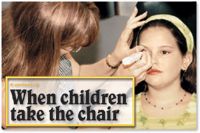Article
When children take the chair
Children need to wear vision correction for many aspects of their life such as school and recreational activities. Even though most eye care professionals don't believe young children are responsible enough for contacts studies show they had results just as positive as older children. There are many ways to introduce children to contact lenses.

Key Points

Some sporting arenas have even banned regular spectacle frames to encourage children to wear safety recreational frames. However, children may not enjoy wearing safety frames or their family may not be able to afford safety frames, so some children participate in sporting activities without vision correction. Other children may refuse to wear vision correction simply because of vanity or fear of being teased. Those children's vision may be compromised when they need it most-during school.
Even though all those children would be much better served by using vision correction, many eye-care professionals (ECPs) refuse to fit children with contact lenses because they believe they are not responsible enough to care for contact lenses properly. Some ECPs say, "Children can't brush their teeth correctly. Why would they clean their contact lenses?" The two situations are not the same. Brushing one's teeth helps prevent tooth decay and, ultimately, tooth loss as an adult. Cleaning one's contact lenses allows the user to see clearly without having to wear glasses during school or sports.
Survey said
Results of the recent Contact Lenses in Pediatrics study showed that children aged 8 to 12 years and teenagers aged 13 to 17 years have similar healthy vision responses to contact lenses, report similar benefits, and require similar amounts of chair time over a series of fitting visits to the ECP. Including fitting the contact lenses, insertion and removal training, and three follow-up visits, children took approximately 10 minutes more time than did teens. The extra time was spent with a staff member during insertion and removal training, meaning that fitting children with contact lenses should not affect the ECP's productivity.
So, children are capable of contact lens wear and they may benefit from constant vision correction throughout the day. As ECPs, we should be ready to fit a younger population of patients with contact lenses.
Before the fitting, discuss the parent's and the child's expectations for contact lens wear. Myopic parents frequently want to slow the progression of their child's nearsightedness. Gas-permeable contact lenses should not be fitted simply to slow the progression of nearsightedness because recently conducted randomized clinical trials have found that alignment fitted gas-permeable contact lenses do not slow the progression of myopia. The only treatment that may slow the progression of myopia is corneal reshaping contact lenses.
Most children are excellent candidates for soft contact lens wear. The modality of soft contact lens wear should be carefully considered. Frequent-replacement contact lenses are the most commonly prescribed contact lenses in the United States, and they may be perfect for many children. Some parents want to teach their children responsibility by giving them frequent-replacement contact lenses that must be cleaned every night. Children may also have siblings or parents who wear frequent-replacement contact lenses, so they may (or may not) benefit from having a role model with similar contact lenses. Frequent-replacement contact lenses are also cost effective, which may be the deciding factor for many parents.
However, the most appropriate modality for children (or any contact lens wearer) is daily disposable. This eliminates the need to care for the lenses and decreases the potential for overwear. Although the cost may initially cause sticker shock, parents often find that the convenience is worth the price, especially for the ease-of-handling for their children. Although continuous-wear contact lenses also reduce the need for daily care, children (and adults) must learn to insert and remove their contact lenses easily so they can care for them appropriately, even in times of eye pain.
Newsletter
Don’t miss out—get Ophthalmology Times updates on the latest clinical advancements and expert interviews, straight to your inbox.




